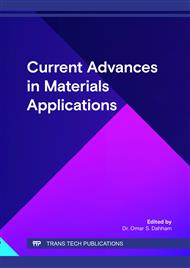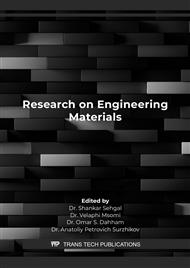[1]
A. A. Hassan, H. T. Naeem, and R. T. Hadi , A Comparative Study of Chemical Material Additives on Polyacrylamide to Treatment of Waste Water in Refineries, IOP Conf. Ser. Mater. Sci. Eng., vol. 518, no. 6, p.62003, 2019.
DOI: 10.1088/1757-899x/518/6/062003
Google Scholar
[2]
I. H. Ahmed, A. A. Hassan, and H. K. Sultan , Study of Electro-Fenton Oxidation for the Removal of oil content in refinery wastewater, IOP Conf. Ser. Mater. Sci. Eng., vol. 1090, no. 1, p.012005, (2021).
DOI: 10.1088/1757-899x/1090/1/012005
Google Scholar
[3]
H. K. Sultan, H. Y. Aziz, B. H. Maula, A. A. Hasan, and W. A. Hatem , Evaluation of Contaminated Water Treatment on the Durability of Steel Piles ,Hindawi Advances in Civil Engineering, vol. 2020, p . 1269563, (2020).
DOI: 10.1155/2020/1269563
Google Scholar
[4]
A. A. Hassan and K. M. M. Al-Zobai , Chemical oxidation for oil separation from oilfield produced water under uv irradiation using titanium dioxide as a nano-photocatalyst by batch and continuous techniques, Int. J. Chem. Eng., vol. 2019, 2019.
DOI: 10.1155/2019/9810728
Google Scholar
[5]
S. F. Alturki, A. H. Ghareeb, R. T. Hadi, and A. A. Hassan , Evaluation of Using Photovoltaic Cell in the Electro-Fenton Oxidation for the Removal of Oil Content in Refinery Wastewater, IOP Conf. Ser. Mater. Sci. Eng., vol. 1090, no. 1, p.012012, (2021).
DOI: 10.1088/1757-899x/1090/1/012012
Google Scholar
[6]
A. S. Atiyah, A. A. A. Al-Samawi, and A. A. Hassan, Photovoltaic cell electro-Fenton oxidation for treatment oily wastewater ,AIP Conf. Proc., vol. 2235, no. May, (2020).
DOI: 10.1063/5.0008937
Google Scholar
[7]
K. M. M. Al-zobai, A. A. Hassan, and N. O. Kariem , Removal of amoxicillin from polluted water using UV/TiO2, UV/ZnO/TiO2, and UV/ZnO, Solid State Technol., vol. 63, no. 3, p.3567–3575, (2020).
Google Scholar
[8]
A. A. Hassan and H. T. Naeem, Degradation of oily waste water in aqueous phase using solar (ZnO, TiO2 and Al2O3) catalysts ,Pak. J. Biotechnol., vol. 15, no. December, p.927–934, (2018).
Google Scholar
[9]
A. H. Rashid, A. A.hassan, R. T. Hadi, and A. S. Naje, Treatment of oil content in oilfield produced water using chemically modified waste sawdust as biosorbent, Ecol. Environ. Conserv., vol. 26, no. 4, p.1563–1571, (2020).
Google Scholar
[10]
A. Saleh Jafer and A.A. Hassan, Removal of oil content in oilfield produced water using chemically modified kiwi peels as efficient low-cost adsorbent, J. Phys. Conf. Ser., vol. 1294, no. 7, 2019.
DOI: 10.1088/1742-6596/1294/7/072013
Google Scholar
[11]
A. A. Hassan, R. T. Hadi, A. H. Rashid, and A. S. Naje , Chemical modification of castor oil as adsorbent material for oil content removal from oilfield produced water , Pollut. Res., vol. 39, no. 4, p.892–900, (2020).
Google Scholar
[12]
O. Abdelwahab, S. M. Nasr, and W. M. Thabet , Palm fibers and modified palm fibers adsorbents for different oils, Alexandria Eng. J., vol. 56, no. 4, p.749–755, 2017.
DOI: 10.1016/j.aej.2016.11.020
Google Scholar
[13]
S. T. Yoganandham, R. R. S. Ravindranath, G. Sathyamoorthy, R. R. Renuka, and A. Lakshminarayanan, Hematite nanoparticles , Palm fibers and modified palm fibers adsorbents for different oils, Research Journal of Biotechnology, vol. 14, no. 6. p.21–30, (2019).
Google Scholar
[14]
K. Simeonidis et al., Magnetic separation of hematite-coated Fe3O4 particles used as arsenic adsorbents,Chem. Eng. J., vol. 168, no. 3, p.1008–1015, (2011).
DOI: 10.1016/j.cej.2011.01.074
Google Scholar
[15]
G. F. Naser, I. H. Dakhil, and A. A. Hasan , Organic pollutants removal from oilfield produced water using nano magnetite as adsorbent, Glob. NEST J., vol. 23, no. 3, p.381–387, (2021).
DOI: 10.30955/gnj.003875
Google Scholar
[16]
A.S. Jafer, A.A. Hassan, and Z.T. Naeem, a Study on the Potential of Moringa Seeds in Adsorption of Organic Content From Water Collected From Oilfield Refinery, Pakistan J. Biotechnol., vol. 16, no. 1, p.27–33, 2019.
DOI: 10.34016/pjbt.2019.16.1.5
Google Scholar
[17]
M. Saberi and P. Rouhi , Extension of the Brunauer-Emmett-Teller (BET) model for sorption of gas mixtures on the solid substances, Fluid Phase Equilib., vol. 534, p.112968, 2021.
DOI: 10.1016/j.fluid.2021.112968
Google Scholar
[18]
M. Teimouri, H. Khorsandi, A. A. Aghapour, and S. J. Jafari , Degradation and Mineralization of Malachite Green Dye in Aqueous Solution by Electro-Fenton Process Using Iron Electrodes, Int. J. Heal. Life Sci., vol. 4, no. 1, p.1–6, 2018.
DOI: 10.5812/ijhls.79605
Google Scholar
[19]
M. K. Ibrahim, A. A. Al-Hassan, and A. S. Naje , Utilisation of cassia surattensis seeds as natural adsorbent for oil content removal in oilfield produced water, Pertanika J. Sci. Technol., vol. 27, no. 4, p.2123–2138, (2019).
Google Scholar
[20]
N. El Messaoudi, M. El Khomri, S. Bentahar, A. Dbik, A. Lacherai, and B. Bakiz, Evaluation of performance of chemically treated date stones: Application for the removal of cationic dyes from aqueous solutions, J. Taiwan Inst. Chem. Eng., vol. 67, p.244–253, 2016.
DOI: 10.1016/j.jtice.2016.07.024
Google Scholar
[21]
G. Shen et al. , Low-Spin-State Hematite with Superior Adsorption of Anionic Contaminations for Water Purification, Adv. Mater., vol. 32, no. 11, p.1–9, 2020.
DOI: 10.1002/adma.201905988
Google Scholar
[22]
M. F. Attallah, I. M. Ahmed, and M. M. Hamed, Treatment of industrial wastewater containing Congo Red and Naphthol Green B using low-cost adsorbent, Environ. Sci. Pollut. Res., vol. 20, no. 2, p.1106–1116, (2013).
DOI: 10.1007/s11356-012-0947-4
Google Scholar
[23]
S. B. Farise, H. A. Alabdly, and A. A. Hasan , Lead Removal from Simulated Wastewater Using Magnetite As Adsorbent with Box-Behnken Design, IOP Conf. Ser. Earth Environ. Sci., vol. 790, no. 1, 2021.
DOI: 10.1088/1755-1315/790/1/012020
Google Scholar
[24]
M. K. Dahri, M. R. R. Kooh, and L. B. L. Lim , Application of Casuarina equisetifolia needle for the removal of methylene blue and malachite green dyes from aqueous solution , Alexandria Eng. J., vol. 54, no. 4, p.1253–1263, 2015.
DOI: 10.1016/j.aej.2015.07.005
Google Scholar
[25]
Z. Liu et al. , An Efficient Adsorption of Manganese Oxides/Activated Carbon Composite for Lead(II) Ions from Aqueous Solution, Arab. J. Sci. Eng., vol. 43, no. 5, p.2155–2165, 2018.
DOI: 10.1007/s13369-017-2514-2
Google Scholar




